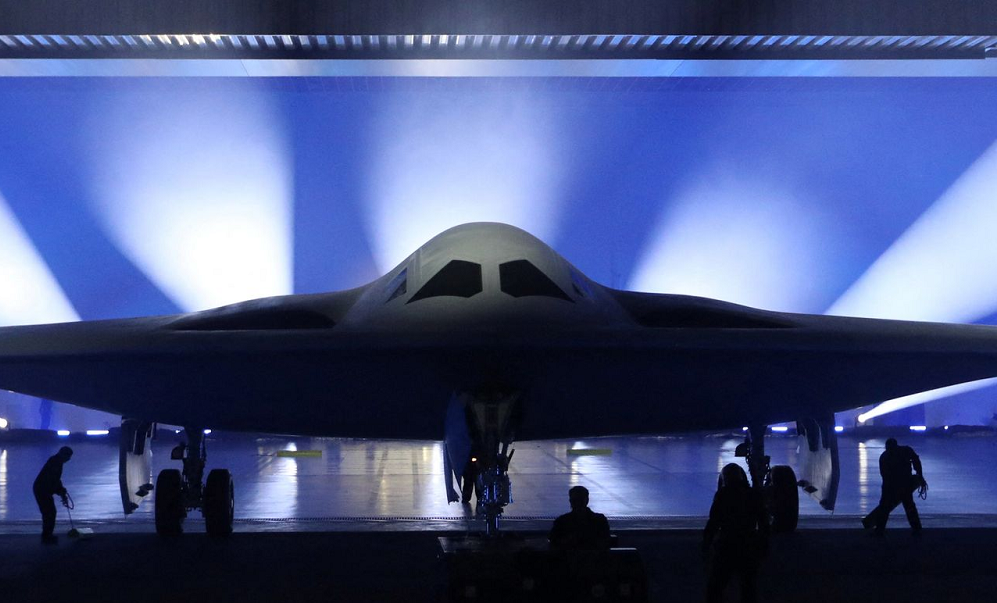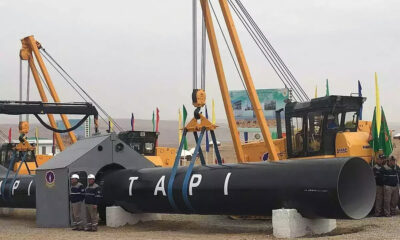Science & Technology
US unveils its latest nuclear stealth bomber

America’s newest nuclear stealth bomber made its debut Friday after years of secret development, and as part of the Pentagon’s answer to rising concerns over a future conflict with China.
The B-21 Raider is the first new American bomber aircraft in more than 30 years. Almost every aspect of the program is classified, Associated Press reported.
As evening fell over the Air Force’s Plant 42 in Palmdale, California, the public got its first glimpse of the Raider in a tightly controlled ceremony. It started with a flyover of the three bombers still in service: the B-52 Stratofortress, the B-1 Lancer and the B-2 Spirit. Then the hangar doors slowly opened and the B-21 was towed partially out of the building.
“This isn’t just another airplane,” Defense Secretary Lloyd Austin said. “It’s the embodiment of America’s determination to defend the republic that we all love.”
The B-21 is part of the Pentagon’s efforts to modernize all three legs of its nuclear triad, which includes silo-launched nuclear ballistic missiles and submarine-launched warheads, as it shifts from the counterterrorism campaigns of recent decades to meet China’s rapid military modernization.
China is on track to have 1,500 nuclear weapons by 2035, and its gains in hypersonics, cyber warfare and space capabilities present “the most consequential and systemic challenge to U.S. national security and the free and open international system,” the Pentagon said this week in its annual China report.
“We needed a new bomber for the 21st Century that would allow us to take on much more complicated threats, like the threats that we fear we would one day face from China, Russia, ” said Deborah Lee James, the Air Force secretary when the Raider contract was announced in 2015.
While the Raider may resemble the B-2, once you get inside, the similarities stop, said Kathy Warden, chief executive of Northrop Grumman Corp., which is building the bomber.
“The way it operates internally is extremely advanced compared to the B-2, because the technology has evolved so much in terms of the computing capability that we can now embed in the software of the B-21,” Warden said.
Other changes include advanced materials used in coatings to make the bomber harder to detect, Austin said.
“Fifty years of advances in low-observable technology have gone into this aircraft,” Austin said. “Even the most sophisticated air defense systems will struggle to detect a B-21 in the sky.”
Other advances likely include new ways to control electronic emissions, so the bomber could spoof adversary radars and disguise itself as another object, and use of new propulsion technologies, several defense analysts said.
“It is incredibly low observability,” Warden said. “You’ll hear it, but you really won’t see it.”
Six Raiders are in production. The Air Force plans to build 100 that can deploy either nuclear weapons or conventional bombs, and can be used with or without a human crew. Both the Air Force and Northrop also point to the Raider’s relatively quick development: The bomber went from contract award to debut in seven years. Other new fighter and ship programs have taken decades.
The cost of the bombers is unknown. The Air Force previously put the price at an average cost of $550 million each in 2010 dollars – roughly $753 million today — but it’s unclear how much is actually being spent. The total will depend on how many bombers the Pentagon buys.
“We will soon fly this aircraft, test it, and then move it into production. And we will build the bomber force in numbers suited to the strategic environment ahead,” Austin said.
Ellsworth Air Force Base in South Dakota will house the bomber’s first training program and squadron, though the bombers are also expected to be stationed at bases in Texas and Missouri.
Science & Technology
Global cyber outage grounds flights and disrupts businesses

A global tech outage was disrupting operations in multiple industries on Friday, with airlines halting flights, some broadcasters off-air and everything from banking to healthcare hit by system problems.
American Airlines (AAL.O), Delta Airlines (DAL.N), United Airlines (UAL.O), and Allegiant Air (ALGT.O), grounded flights citing communication problems. The order came shortly after Microsoft (MSFT.O), said it resolved its cloud services outage that impacted several low-cost carriers, though it was not immediately clear whether those were related, Reuters reported.
“A third party software outage is impacting computer systems worldwide, including at United. While we work to restore those systems, we are holding all aircraft at their departure airports,” United said in a statement. “Flights already airborne are continuing to their destinations.”
Australia’s government said outages suffered by media, banks and telecoms companies there appeared to be linked to an issue at global cybersecurity firm Crowdstrike (CRWD.O).
According to an alert sent by Crowdstrike to its clients and reviewed by Reuters, the company’s “Falcon Sensor” software is causing Microsoft Windows to crash and display a blue screen, known informally as the “Blue Screen of Death”.
The alert, which was sent at 0530 GMT on Friday, also shared a manual workaround to rectify the issue.
A Crowdstrike spokesperson did not respond to emails or calls requesting comment.
There was no information to suggest the outage was a cyber security incident, the office of Australia’s National Cyber Security Coordinator Michelle McGuinness said in a post on X.
The outages rippled far and wide.
The travel industry was among the hardest hit with airports around the world, including Tokyo, Amsterdam, Berlin and several Spanish airports reporting problems with their systems and delays.
International airlines, including Ryanair (RYA.I), Europe’s largest airline by passenger numbers, warned of problems with their booking systems and other disruptions.
In Britain, booking systems used by doctors were offline, multiple reports from medical officials on X said, while Sky News, one of the country’s major news broadcasters was off air, apologising for being unable to transmit live.
Banks and other financial institutions from Australia to India and South Africa warned clients about disruptions to their services, while LSEG Group (LSEG.L), reported an outage of its data and news platform Workspace.
Amazon’s AWS cloud service provider said in a statement that it was “investigating reports of connectivity issues to Windows EC2 instances and Workspaces within AWS.”
It was not immediately clear whether all reported outages were linked to Crowdstrike problems or there were other issues at play.
Science & Technology
Samsung unveils exclusive Galaxy Z Flip6 Olympic Edition for Paris 2024 athletes

Samsung Electronics Co., Ltd., a Worldwide Olympic and Paralympic Partner, this week revealed the Olympic Edition of its newly announced Galaxy Z Flip6, exclusively designed and customized for all athletes competing at the upcoming Olympic and Paralympic Games Paris 2024.
The Galaxy Z Flip6 Olympic Edition for Paris 2024 is the first-ever Olympic Edition to feature Galaxy AI.
Designed to elevate the athletes’ Games-time experience from the moment they arrive in Paris, it is the first to come pre-loaded with a full suite of exclusive services and useful apps.
In addition, it marks the first time Samsung’s newest product is being made available to athletes before its official market launch. The Galaxy Z Flip6 will also take center stage at the Olympic Games as the first Olympic Edition to play an integral role on the podium.
It boasts the new Galaxy Z Flip6’s compact and versatile design, in a striking yellow colorway adorned with the Olympic rings and Paralympic agitos in gold.
To dress up the phone, Samsung partnered with the Parisian Men’s Luxury Maison, Berluti, who designed the Team France’s official outfits for the Paris 2024 Opening Ceremony, to create an exclusive Flipsuit Case that will accompany each device. Made from Venezia leather, each Flipsuit Case has a unique patina featuring a vibrant color mix inspired by the Olympic rings, celebrating the Olympic spirit and values of excellence and unity.
“Samsung has pushed the boundaries of mobile technology in support of the Olympic and Paralympic Games and its athletes for nearly three decades,” said Stephanie Choi, EVP & Head of Marketing of Mobile eXperience Business at Samsung Electronics.
“We are honored to deliver our newest Galaxy innovation to the inspiring athletes of Paris 2024 — and give them the opportunity to experience the powerful and intelligent Galaxy Z Flip6 firsthand, even before its official market launch. We are excited to see how our technology opens up athletes’ Games-time experience like never before — from creating meaningful connections, to sharing and capturing lifelong memories while in Paris and beyond.”
The Galaxy Z Flip6 Olympic Edition includes a range of useful innovations to help athletes .
Among these is live translation of calls. This translates phone calls directly on the device in real-time into 16 different languages, making it easy for athletes to call the Olympic hotlines and local contacts in their native language.
It also instantly translates live conversations, allowing athletes to chat with other athletes and volunteers and receive a live translation of what they’re saying on screen – while still speaking face-to-face.
It also helps to draft emails and social media posts in apps by using simple keywords and it allows athletes to record, share and analyze their performances in slow motion.
Additionally, to keep track of the latest Games-time schedules and travel around the Olympic venues with ease, several official International Olympic Committee (IOC) apps such as Athlete 365,6 Olympic Shop, Paris 2024, Transport Accred App, and IOC hotline will be pre-loaded.
When and how to watch the games.
Ariana Television Network (ATN) has secured the exclusive rights to broadcast the Olympic Games in Afghanistan.
The global sporting event gets underway on 26 July and will run through until 11 August 2024.
Fans in the country will be able to tune in to Ariana Television to watch the event.
Science & Technology
China leads the world in adoption of generative AI, survey shows
The SAS report also said China led the world in continuous automated monitoring (CAM), which it described as “a controversial but widely-deployed use case for generative AI tools”.

China is leading the world in adopting generative AI, a new survey shows, the latest sign the country is making strides in the technology that gained global attention after U.S.-based OpenAI’s ChatGPT launched in late 2022, Reuters reported.
In a survey of 1,600 decision-makers in industries worldwide by U.S. AI and analytics software company SAS and Coleman Parkes Research, 83% of Chinese respondents said they used generative AI, the technology underpinning ChatGPT.
That was higher than the 16 other countries and regions in the survey, including the United States, where 65% of respondents said they had adopted GenAI.
The global average was 54%, read the report.
The industries surveyed included banking, insurance, healthcare, telecommunications, manufacturing, retail and energy.
The results underscore China’s rapid progress in the generative AI field, which gained momentum after Microsoft-backed OpenAI released ChatGPT in November 2022, prompting dozens of Chinese companies to launch their own versions.
Last week, a report by the United Nations’ World Intellectual Property Organization showed China was leading the GenAI patent race, filing more than 38,000 between 2014 and 2023 against 6,276 filed by the United States in the same period.
While many leading international generative AI service providers, including OpenAI, face curbs in China, the country has developed a robust domestic industry, with offerings from tech giants such as ByteDance to startups such as Zhipu.
Enterprise adoption of generative AI in China is expected to accelerate as a price war is likely to further reduce the cost of large language model services for businesses, Reuters reported.
The SAS report also said China led the world in continuous automated monitoring (CAM), which it described as “a controversial but widely-deployed use case for generative AI tools”.
This technology can collect and analyze vast amounts of data on users’ activities, behaviour and communications, which can lead to privacy infringements as they are not aware of the extent of the data being collected or how it is used, said Udo Sglavo, vice president of applied AI and modelling at SAS.
“The algorithms and processes used in CAM are often proprietary and not transparent,” Sglavo added.
“This can make it difficult to hold the entities using CAM accountable for misuse or errors.”
He added, “China’s advancements in CAM contribute to its broader strategy of becoming a global leader in artificial intelligence and surveillance technologies.”
-

 Sport4 days ago
Sport4 days agoOlympics finally here; What you need to know
-

 Latest News5 days ago
Latest News5 days agoOCHA reports 110 die in landmine explosions in Afghanistan every month
-

 Regional5 days ago
Regional5 days agoChina braces for twin tropical cyclones after deadly flash floods
-

 Health4 days ago
Health4 days agoHealth partners provide services 589,205 people in Afghanistan in last month
-

 Latest News4 days ago
Latest News4 days agoAfghanistan’s Hajj ministry confirms death of 27 pilgrims in Mecca and Medina
-

 Business5 days ago
Business5 days agoConference on Islamic microfinance kicks off in Kabul
-

 Sport4 days ago
Sport4 days agoACB proposes ODI fixtures against top-tiered teams
-

 Latest News4 days ago
Latest News4 days agoIslamabad claims three terrorists killed at Pakistan-Afghanistan border

























